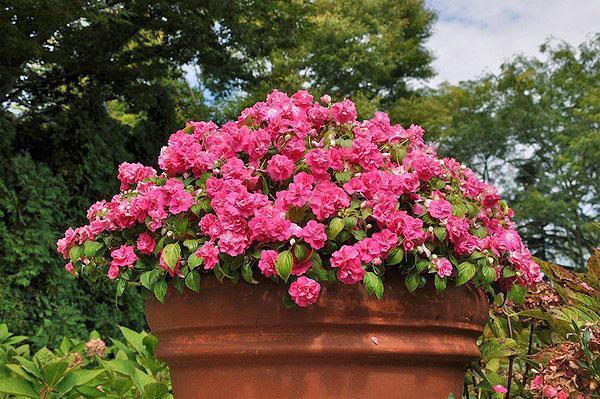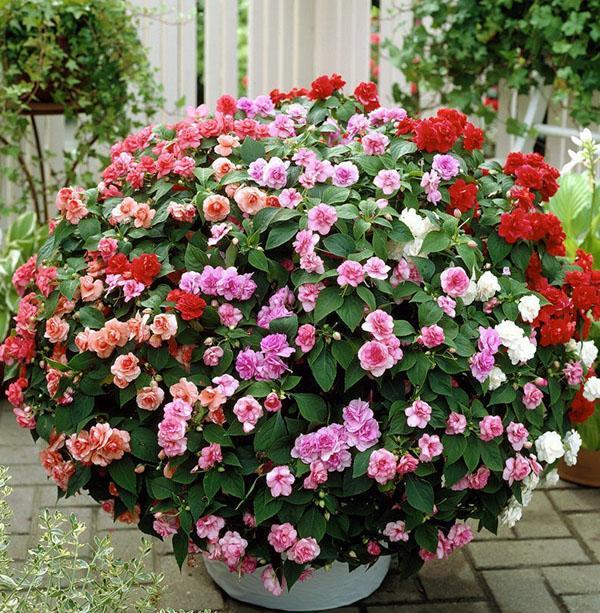Garden and indoor touch-me-not balsam
 The genus Impatiens, which can be translated as "untouchable" or "touchy", is the basis of the Balsamic family and consists of half a thousand species that grow throughout the planet.
The genus Impatiens, which can be translated as "untouchable" or "touchy", is the basis of the Balsamic family and consists of half a thousand species that grow throughout the planet.
Due to the prevalence and diversity of plants, it is impossible to indicate the exact place on the map, worthy of being called home balsam plants... They are found throughout the world in temperate and tropical regions, but there are several main centers of concentration of the species. These are, first of all, Asia and African countries, North America and Europe.
The history of the discovery and study of balsams

The most famous species in our country is Waller's indoor balsam, which grows in the wild off the east coast of Africa in the Zanzibar archipelago.
It was here that new plants for botanists were discovered in 1861. Several specimens, originally named after the local ruler, were shipped to Europe by the British naturalist John Kirk. Here, the attentiveness of the English missionary Horace Waller, who first noticed the unknown plant, and his find were appreciated. And the African touch-me-not got the name Impatiens walleriana in 1896.
The plant is loved by residents of many countries. Today, the continuously blooming indoor balsam in the West is often called Busy Lizzie, and in Russia the culture is called Vanka Wet's light. Such an unusual, even familiar name is explained by the peculiarity of the plant, which forms small droplets of sweet liquid on the leaves, which eventually turn into hard sugar balls.
 Among garden balsams, in the photo, Impatiens balsamina stands out - a small but very attractive native of South Asia, decorating flower beds and borders in many regions of Russia.
Among garden balsams, in the photo, Impatiens balsamina stands out - a small but very attractive native of South Asia, decorating flower beds and borders in many regions of Russia.
In the 20th century, flower growers were able to get acquainted with an extensive group of hybrids from New Guinea. Now these exotic plants are available to collectors and indoor crop lovers, and some varieties in mid-latitudes have felt so comfortable that they have become real weeds, displacing native species from their usual places.
 This fully applies to the Himalayan balsam, which a hundred years ago was found only in its homeland.
This fully applies to the Himalayan balsam, which a hundred years ago was found only in its homeland.
What does balsam look like?
Among the hard-to-reach, or, as they are used to call them in Russia, balsamines are wild, garden and home crops. Annual plants in the middle lane are grown as garden balsams, and indoor varieties are crops whose growing season lasts for several years.
Thanks to the active selection work begun in the middle of the last century and the popularization of unpretentious, willingly flowering species, balsams have taken a worthy place in the collections of flower growers.
At the same time, they are so different from each other in the shape and color of flowers, sizes and habitats that it is difficult to even suspect representatives of different species of belonging to the same genus. Among the balsams are:
- herbaceous annuals and perennial varieties that look like small trees or dwarf shrubs;
- dwarfs no higher than 20 cm and giants 2 meters in height;
- frost-resistant and accustomed to living only in warm tropical climates.
Therefore, the answer to the question: "What do balsams look like?" cannot be simple and monosyllabic.
 But with a lot of differences, balsams from different parts of the world have a lot in common. Plants are called touchy because of the peculiarity inherent in many species. The slightest touch to the juicy fruit-box causes its instant disclosure, and the contents scatter with great force over a distance of several meters.
But with a lot of differences, balsams from different parts of the world have a lot in common. Plants are called touchy because of the peculiarity inherent in many species. The slightest touch to the juicy fruit-box causes its instant disclosure, and the contents scatter with great force over a distance of several meters.
In the plant world, balsams are considered to be a kind of champions in terms of a variety of shapes and colors of corollas.
 Flowers of indoor balsam and its garden counterparts can be simple and double, monochromatic and two-colored, with a bright contrasting center or a scattering of spots on the petals.
Flowers of indoor balsam and its garden counterparts can be simple and double, monochromatic and two-colored, with a bright contrasting center or a scattering of spots on the petals.
The average flower diameter of indoor balsam is 2–4 cm, but there are also plants that delight owners with larger corollas of bright colors. A characteristic feature of the balsam flower is a thin curved spur, but the shape and size of the petals can be different:
- Waller's room balsam has flattened corollas, and the petals that make up them are almost the same.
- In other varieties, due to the shortened asymmetric petals, the flowers look more like violets or snapdragons.
This diversity is associated with different plant habitats and which insects are involved in pollination.
Features of balsam plants
 The vast majority of indoor and garden balsams love shade, there are few exceptions to this rule. First of all, these are plants from New Guinea and, for example, the wild-growing balsam glandulifera. But moisture is vital for all touch-sensitives, but moisture-loving species have to protect flowers and leaves from an excess of water.
The vast majority of indoor and garden balsams love shade, there are few exceptions to this rule. First of all, these are plants from New Guinea and, for example, the wild-growing balsam glandulifera. But moisture is vital for all touch-sensitives, but moisture-loving species have to protect flowers and leaves from an excess of water.
Smooth lanceolate leaves of balsams do not differ in richness of forms, but can have both monochromatic and variegated colors. Interestingly, thanks to a special coating, the surface of the leaf plate, drops roll off it, and the leaf remains dry even in heavy rain. The underside is protected from getting wet and decay by a mass of tiny air bubbles trapped between the villi.
The flowers are protected from dew and rain by the pedicels lengthening as the corolla opens. As a result, the flower of the garden balsam, as in the photo, bends, and the streams of water cannot wash off the ripe pollen.